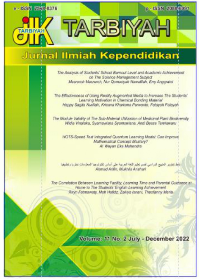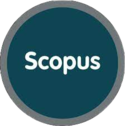The Module Validity of The Sub-Material Utilization of Medicinal Plant Biodiversity
DOI:
https://doi.org/10.18592/tarbiyah.v11i2.7231Abstract
The aim of the study was to determine the feasibility of the module as a sub-material for the use of biodiversity for class X SMA. Using Research and Development (R&D) research methods with a qualitative descriptive approach. This study validated the instrument and validated the module teaching materials. The selection of validators with purposive sampling technique which consists of 5 validators. Module validation to obtain quantitative data accurately through a Likert scale. The assessment aspect of the module contains the feasibility of content, language, presentation, and graphics. The validation results obtained through the validator were analyzed using the CVR formula and continued to CVI, the results of the analysis of 4 aspects of the assessment namely the feasibility of content, language, presentation, and graphics consisting of 15 indicators of module feasibility assessment obtained a CVI value of 0.99 which is said to be a valid module and proper to use.The aim of the study was to determine the feasibility of the module as a sub-material for the use of biodiversity for class X SMA. Using Research and Development (R&D) research methods with a qualitative descriptive approach. This study validated the instrument and validated the module teaching materials. The selection of validators with purposive sampling technique which consists of 5 validators. Module validation to obtain quantitative data accurately through a Likert scale. The assessment aspect of the module contains the feasibility of content, language, presentation, and graphics. The validation results obtained through the validator were analyzed using the CVR formula and continued to CVI, the results of the analysis of 4 aspects of the assessment namely the feasibility of content, language, presentation, and graphics consisting of 15 indicators of module feasibility assessment obtained a CVI value of 0.99 which is said to be a valid module and proper to use.References
Amri, S & Ahmadi, K. I. (2010). Konstruksi Pengembangan Pembelajaran (Pengaruh Terhadap Mekanisme dan Praktik Kurikulum). Jakarta: PT Prestasi Pustaka.
Bahtiar, E.F.(2015). Penulisan Bahan Ajar. 2015: Fakultas Kehutanan, Institut Penelitian Bogor.
Daryanto. (2013). Menyusun Modul (Bahan Ajar Untuk Persiapan Guru Dalam Mengajar). Yogyakarta: Gava Media.
Depdiknas. (2008). Penulisan Modul. Jakarta.: Departemen Pendidikan Nasional.
E. Mulyasa. (2008). Kurikulum Berbasis Kompetensi: Konsep, Karakteristik, Implementasi, dan Inovasi. Bandung: Remaja Rosdakarya.
Fajarini, A., Soetjipto, B.E., Hanurawan, F. (2016). Developing A Social Studies Modul by Using Problem Based Learning (PBL) With Scaffolding for the Seventh Grade Students in A Junior High Scholl in Malang, Indonesia. Journal of Research and Method in Education. 6(1): 62-69. (Online) (https://www.iosrjournals.org/iosr-jrme/papers/Vol-6%20Issue-1/Version-3/L06136269.pdf)
Irnaningtyas. (2013). Biologi Untuk SMA/MA Kelas X. Jakarta: Erlangga.
Mahmud. (2011). Metode Penelitian Pendidikan. Bandung: Pustaka Setia.
Nurlatipah, N. Juanda, A. dan Maryuningsih, Y. (2015). Pengembangan Media Pembelajaran Komik Sains yang disertai Foto untuk Meningkatkan Hasil Belajar Siswa Kelas VII SMPN 2 Sumber pada Pokok Bahasan Ekosistem. Scientiae Education: Jurnal Pendidikan Sains Vol. 5. (Online) (https://ejournal.iainpalopo.ac.id/index.php/PiJIES/article/view/2423/1689)
Sadiman, A.S., Rahardjo, R., Haryono A., dan Harjito. (2014). Media Pendidikan: pengertian, pengembangan dan pemanfaatannya. Depok: PT. Raja Grafindo Persada.
Sanjaya, W. (2012). Media Komunikasi Pembelajaran. Jakarta: Kencana.
Sudjana, N & Rivai A. (2013). Media Pembelajaran. Bandung: CV Wacana Prima.
Sugiyono. (2017). Metode Penelitian Pendidikan (Pendekatan Kuantitatif, Kualitatif, dan R & D). Bandung: ALFABETA.
Sugiyono. (2018). Metode Penelitian Kuantitatif Kualitatif dan R & D. Bandung: Alfabeta.
Zulfadli. (2017). Pengembangan Modul Biologi pada Materi Ekosistem Berbasis Pembelajaran Berbasis Masalah untuk Siswa Kelas X SMA Muhammadiyah Kota Tarakan. Jurnal Bionature, 17 (1). (Online) (https://online-journal.unja.ac.id/biodik/article/view/14758)
Downloads
Published
How to Cite
Issue
Section
License
Authors retain copyright and grant the journal right of first publication with the work simultaneously licensed under a Creative Commons Attribution 4.0 International License that allows others to share the work with an acknowledgment of the work's authorship and initial publication in this journal.




